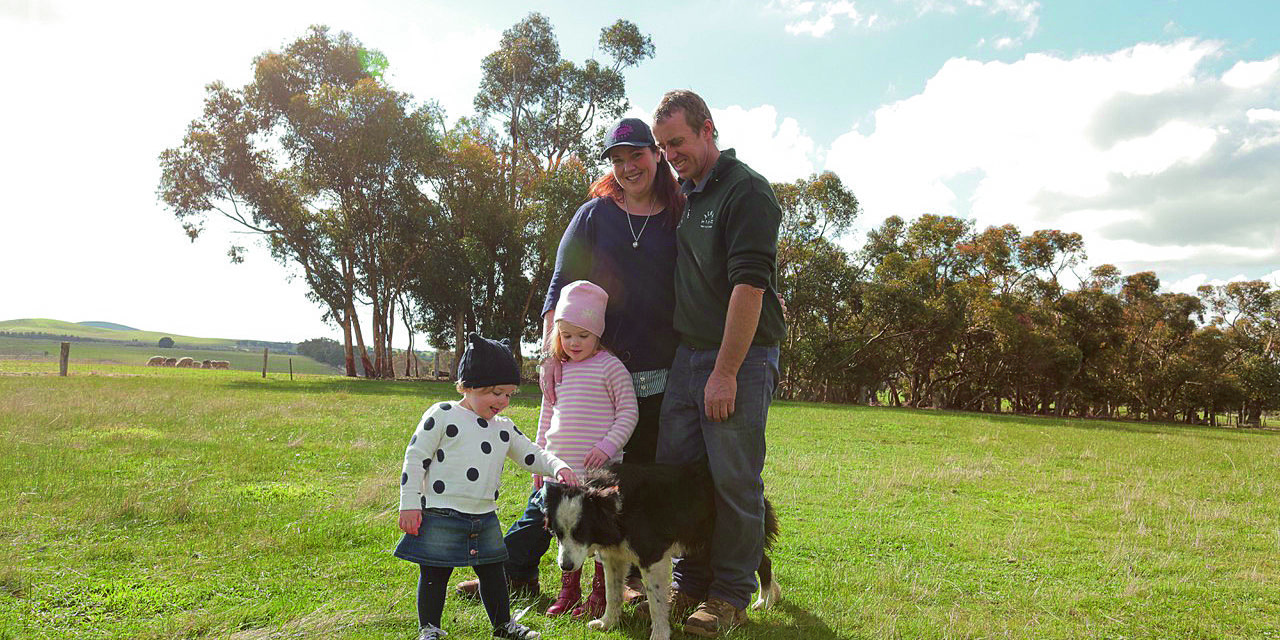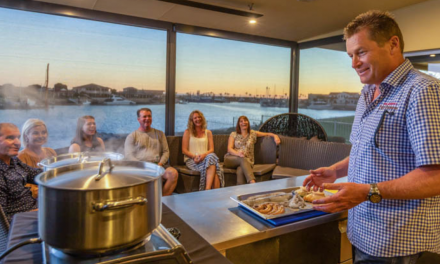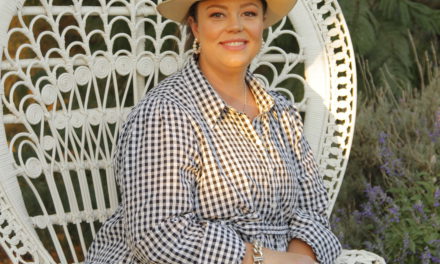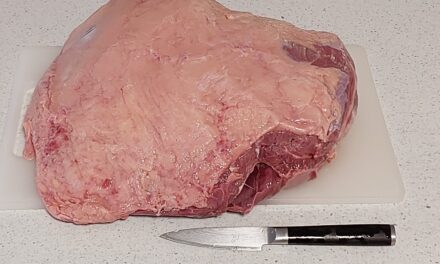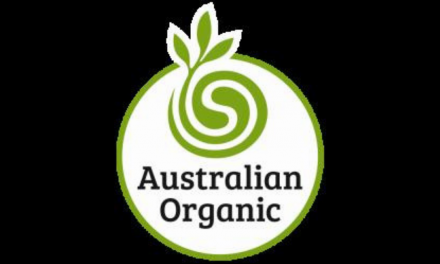It’s still a very small on-farm enterprise but for one wool growing couple in central Victoria, turning their finest Merino fleece wool into some spectacular signature garments has become as much a mission as a marketing exercise. SOPHIE BALDWIN caught up with the people behind the very trendy Leroy Mac Designs label — not long after the property had been devastated by fire earlier this year
YOU would think the process of turning Merino wool into yarn would be a relatively simple one. That’s been done not just for years, even decades but for countless generations.
However, it turns out that’s not quite right.
About 160 km northwest of Melbourne, Lexton livestock farmers Rod and Rebecca McErvale spent years looking for someone who had the facilities to turn homegrown fleece into wool so they could make quality, Australian-owned blankets, beanies, throws and workwear under their Leroy Mac label.
And in the end all it took was a chance meeting with an old friend Rod knew from his primary school days to get the ball rolling.
Three weeks later, after cobbling together as much greasy fleece wool as they could, their product was down on the wharf waiting to be shipped to northern Italy where it would be processed.
“We were lucky to be able to piggyback our first lot of wool with Andrew Ross from Bluey Merino Australia, who was sending his own wool overseas to be made into athletic gear,” Rod said.
That first year they sent just 350 kg of wool and received 210 kg in return — their most recent consignment was 1850 kg and they received around 1300 kg back (extra yield is lost the smaller the batch is).
Their product is DNA tested before leaving the country — and tested again on its return — to ensure they receive the same product they sent away. While it is overseas it is scoured, combed, super-washed and comes back spun and ready for the knitting needle.
Rod laughed as he explained how, when they first started, it cost $35 for a kilo of Merino wool in Australia, their first kilo cost $85.
“We certainly don’t do it to value add, initially it was all about a sense of achievement,” he said.
Rod said the benefit of completing this process with the best clip from the Merinos on their farm results in a supreme quality product, that handles very well and has a beautiful feel and finish.
“It really makes a difference to the quality of the product and we are very proud of what we produce. Leroy Mac now has a good reputation for a quality Australian made product,” he said.
Getting their product out into the marketplace initially involved a lot of work as they travelled to any school fete or market going.
“Every weekend we would be away somewhere but thankfully now we just get to concentrate on the major markets and shows.”
Facebook and Instagram have been huge for business, including recent initiatives to buy from the bush and from fire affected farmers.
“Online orders have been huge for us and now we can’t keep up,”
Rebecca said.
“The benefits of Merino wool include:
One of the best fabrics for children’s wear.
It has a naturally high wick ability rate (which means it absorbs more moisture than cotton from the body, creating a more stable body temperature and giving a much better sleep).
It is difficult to ignite, won’t melt and can self-extinguish, making it an ideal choice in children’s bedding.
It has natural odour fighting and antibacterial properties that absorb and neutralize body odours.
The wool is hypoallergenic — meaning it is resistant to mould, mildew, bacteria and dust mites which can trigger asthma and allergic reactions for some people.
It is naturally elastic and will retain its shape even after being wrapped around your baby or tucked under a cot mattress.
It is a natural and renewable resource that requires no harsh chemicals to process and creates very little carbon footprint. It is also biodegradable so after a long lifespan can be returned to earth for natural recycling.
Merino wool garments retain their appearance and therefore look new for longer.
Leroy Mac products are fully machine washable.”
Rod said while they are happy with the quality of product, the time frame to complete the process is long and drawn out.
They are desperately looking at ways to streamline including the option of dying wool in Australia.
Rod and Rebecca are a great example of the strength and resilience in Australia’s farming community.
They have battled everything mother nature has thrown at them over the years but December 20 she sent them a real curve ball.
In just five short minutes their world turned upside down when fire ravaged their property.
A generation of sheep — 280 mixed sex weaners — gone.
Just a few charred posts are all that remain of 28 km of fencing.
And 95 per cent of their painstakingly nurtured pastures and environmental plantings disappeared; everything grey, turned to ash.
“We had four CFA trucks and two private units on our property but once it got into Ben More the winds picked up and our farm was burnt out in five minutes, it was just incredible,” Rodney said.
Under the cover of darkness it was impossible to tell what had happened to the farm flock of 1200 sheep but first light the next morning revealed the full extent of the flames — 280 burnt weaners.
A generation perished.
“I have been a farmer for 30 years and the toughest thing I have had to endure was the sound of the gun going off as the department shot my injured sheep, it made me cringe every time a shot rang out,” Rodney said.
Rodney said the financial loss of those weaners will be felt for the next six years through breeding losses, loss of wool production and livestock sales.
“My old man is 81 and he reckons this is the toughest year he has ever endured.
“Lack of rain and no green grass made the start of 2019 tough enough and it was followed by a really tough lambing season and to have such a ferocious fire rip through land that has been in your family for nearly a century, well it just about tears your heart out.
“The countryside has been burnt beyond the ground and a lot of the old timers reckon the damage has been so severe the grass won’t come back and soil erosion in our gullies is the next major concern — we need to get that land up and vegetated as soon as possible.”
Rodney said the first week after the fire was just a disaster.
“I had no sleep. The highest priority was to assist the burnt sheep and humanely destroy them and once they were gone it was a huge relief and I could start to think about what next.”
That what-next entailed 28 km of burnt fencing — a seemingly insurmountable distance made so much easier by the arrival of Blaze Aid who have been helping the family get their business back on track.
“To see something happen so quickly has done wonders for my mental health, I was thinking how on earth am I going to do this and to have volunteers just turn up and get the job done has been huge for me mentally,” Rodney said.
Rodney said he is a typical 47-year-old farmer, but he has broken down numerous times since the fires.
“And we have been lucky, we didn’t lose our house or any lives, there are so many more people worse off than us.”
As a former city girl, Rebecca said the journey since the fire had been a roller coaster.
“It has been horrific, and my biggest concern has been my husband and his father. Farming is in their blood and it has been heartbreaking watching their emotions,” Rebecca said.
The family is determined none of this will hold them back and they will continue with Leroy Mac.
“This will affect us for years to come but we are determined to move forward and keep doing what we love,” she said.
And even though the family business was severely impacted by fire, they still found the generosity to donate a couple of semi loads of hay to Rural Aid as part of the sponsorship program they participate in annually — a fire-affected farmer donating hay to another fire-affected farmer is nothing short of extraordinary.
Contact:
Leroy Mac Designs
Yalong Rd
Lexton Victoria 3352
P: (03) 5349 3101
M: 0437 948 429
W: leroymac.co.au

